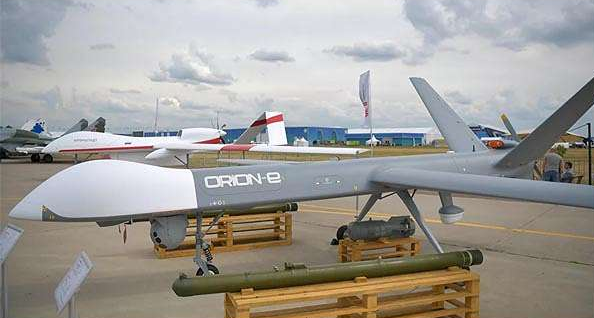TX014 航空機から発射することができる防空域突破作戦用のスワームUAV
IR探知システムとペトリオットシステムでまもまれている防空域を突破する為のUAVスワーム。現行のペトリオットシステムは、1000機のUAVをすべて撃ち落とすことができるか?
Russia Working on Airborne Launch and Recovery Drones
by Ilya Tsukanov
Moscow (Sputnik) Aug 23, 2021
Russia’s defence sector is busy building several new types of unmanned aerial vehicles, including a heavy drone bomber, long-range reconnaissance UAVs, and drone wingmen for its 4++ and fifth-generation fighter jets. The new equipment is expected to help the military even the playing field in an area where Russia has traditionally lagged behind.
Russian drone manufacturer Kronshtadt Group is working on a new type of air-launched swarm UAV that will be able to take off from and return to airborne “motherships,” General Director Sergei Bogatikov has revealed.
The Orion has a maximum takeoff weight of 1,150 kg, a cruising speed of 200 km per hour, a maximum altitude of up to 7 km, a maximum flight time of 24 hours, and a 200 kg payload.

Speaking to Sputnik just before the Army-2021 military expo and technical forum, which is set to kick off outside Moscow on Sunday, Bogatikov explained that some variants of drones from the Molnya (“Lightning”) lineup will be equipped with airborne launch and recovery capability.
“It’s important to understand that the there are several versions of devices from the Molniya series, including reconnaissance, strike and electronic warfare drones. The reconnaissance and electronic warfare variants of the drones [are expected to be returnable], while the strike variants will not, since doing so would simply be dangerous, even if they weren’t used to strike certain targets,” the official explained.
Kronshtadt is looking at the Ilyushin Il-76, the longtime workhorse strategic airlifter used by the Russian military, as one possible platform to carry the Molniya drones and serve as their mothership, according to Bogatikov.
Quantity Has a Quality All Its Own
Bogatikov explained that the principle behind the Molniya system is about using numbers to overload enemy air defences, with “the main idea of swarm solutions being, first and foremost, to break through the enemy’s air defence system.” The official noted that the main Achilles’ heel of modern air defences, which are costly to produce and fire expensive interceptor missiles, is their information channels’ vulnerability to becoming saturated.
“If the system is capable of shooting down 100 targets and it has to shoot down 100 targets, it works. But if it has to shoot down 1,000 targets, it will inevitably fail,” he explained.
Kronshtadt is not the only company working on airborne launch and recovery drones. The Pentagon’s Defence Advanced Research Project Agency (DARPA) and tech company Dynetics have been testing Gremlin drones flying out of a C-130 Hercules “Mothership” aircraft since 2019, but have faced problems retracting the UAVs. Gremlins are designed to be able to carry up to 145 pounds of ordnance or equipment and are expected to conduct reconnaissance, electronic warfare and kinetic attack missions.
Other Designs
Along with the Molniya, Kronshtadt Group is busy working on several other projects, including preliminary conceptual design work for the “Grom,” a heavy strike drone whose possible missions will include combat operations alongside manned aircraft. The Grom was unveiled at the Army-2020 expo, and features a prospective combat payload of up to two tonnes, allowing it to carry both guided air-to-surface missiles and bombs ordinarily carried by manned aircraft, and to travel at speeds of up to 1,000 km per hour.
According to Bogatikov, Kronshtadt has also signed off the blueprints for the Sirius, a dual-engine medium-altitude reconnaissance and strike UAV with the ability to remain airborne for up to 20 hours at a time, and a cruising speed of 180 km per hour. The Sirius has a takeoff weight of up to two tonnes, can be operated by satellite, and has the ability to interact with manned aircraft via the installation of integrated onboard communication, data exchange, and identification systems. The Sirius is envisioned as a heavy variant of the Orion, another Kronshtadt design.
As for the Orion, which was introduced into service last year, that drone too is receiving upgrades, with Bogatikov revealing that plans including equipping the drone with new electronic warfare capabilities, enabling it to defend itself against incoming missile attacks, and to suppress enemy systems on behalf of other units on the battlefield.
The Orion has a maximum takeoff weight of 1,150 kg, a cruising speed of 200 km per hour, a maximum altitude of up to 7 km, a maximum flight time of 24 hours, and a 200 kg payload.
Kronshtadt Group is just one of multiple Russian defence sector companies developing drones and the means to defend against them. Earlier this year, Almaz-Antey, maker of Russia’s S-300, S-400 and S-500 series of air defence systems, showed off a new small drone-hunting UAV designed to shoot down enemy drones. Other systems, including a long-range flying wing combat UAV known as the Okhotnik (“Hunter”) and the Sokol Altius long-endurance recon, strike and electronic attack drone for use by the Air Force and Navy, are also in development. The first batch of Sokol Altius drones is expected to be delivered to the Russian military later this year.
Best regards,
Shoichi Sugiyama, Ph.D.

